
Ottawa County is a county located in the northeastern corner of the U.S. state of Oklahoma. As of the 2020 census, the population was 30,285. Its county seat is Miami. The county was named for the Ottawa Tribe of Oklahoma. It is also the location of the federally recognized Modoc Nation and the Quapaw Nation, which is based in Quapaw.

Osage County is the largest county by area in the U.S. state of Oklahoma. Created in 1907 when Oklahoma was admitted as a state, the county is named for and is home to the federally recognized Osage Nation. The county is coextensive with the Osage Nation Reservation, established by treaty in the 19th century when the Osage relocated there from Kansas. The county seat is in Pawhuska, one of the first three towns established in the county. The total population of the county as of 2020 was 45,818.

Avant is an incorporated community in eastern Osage County, Oklahoma, United States. The population was 320 at the 2010 census, a decline of 14.0 percent from the figure of 372 recorded in 2000.

Burbank is a town in western Osage County, Oklahoma, United States. The population was 141 at the 2010 census, a 9 percent decrease from the figure of 155 recorded in 2000.
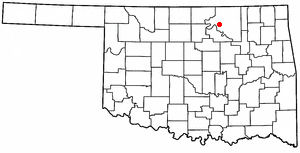
Fairfax is a town in Osage County, Oklahoma, United States. The Osage Nation reservation is coterminous with the county. The population was 1,380 at the 2010 census, down 11.3 percent from the figure of 1,555 recorded in 2000. It was the home of the ballerinas Maria and Marjorie Tallchief.
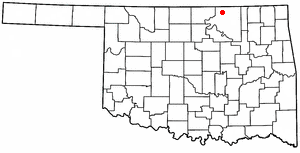
Foraker is a ghost town in Osage County, Oklahoma, United States. It was named for Ohio Senator Joseph B. Foraker. The Tallgrass Prairie Preserve is southeast of town. The official population peaked at 415 in 1910 and has declined steadily since 1930. The population was only 18 at the 2010 census, a 21.7 percent decline from 23 in 2000.

Pawhuska is a city in and the county seat of Osage County, Oklahoma, United States. As of the 2020 census, the population of the city was 2,984. It was named after the 19th-century Osage chief, Paw-Hiu-Skah, which means "White Hair" in English. The Osage tribal government, which opened offices in Pawhuska in 1872 when its reservation was established in Indian Territory, continues to be based in Pawhuska.

Skiatook is a city in Osage and Tulsa counties in the U.S. state of Oklahoma located in the northeastern part of the state, approximately 20 miles north and west of Tulsa. Due to its location on the border between Osage County and Tulsa County, Skiatook has been referred to as "the Gateway to the Osage." The town includes the state highway junction of Oklahoma State Highway 11 and Oklahoma State Highway 20. The population was 8,450 at the 2020 census, an increase of 14.24 percent over the figure of 7,397 recorded in 2010.

The Osage Indian murders were a series of murders of Osage in Osage County, Oklahoma, during the 1910s–1930s.
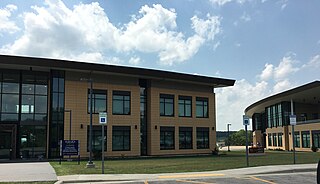
The Osage Nation, is a Midwestern American tribe of the Great Plains. The tribe developed in the Ohio and Mississippi river valleys around 700 B.C. along with other groups of its language family. They migrated west after the 17th century, settling near the confluence of the Missouri and Mississippi rivers, as a result of Iroquois expansion into the Ohio Country in the aftermath of the Beaver Wars.

William King Hale was an American political boss and crime boss in Osage County, Oklahoma who was a major perpetrator in the Osage Indian murders, for which he was later convicted. He made a fortune through cattle ranching, contract killings, and insurance fraud.
Tulsa Public Schools is an independent school district serving the Tulsa, Oklahoma area in Northeastern Oklahoma. As of 2022, it is the largest school district in Oklahoma, surpassing Oklahoma City Public Schools for the first time since 2013. As of 2022 the district serves approximately 33,211 students. It is governed by an elected school board. As of November 2021, the Tulsa Public Schools district is accredited by the Oklahoma State Department of Education.

The Tulsa metropolitan area, officially defined as the Tulsa metropolitan statistical area is a metropolis in northeastern Oklahoma centered around the city of Tulsa and encompassing Tulsa, Rogers, Wagoner, Osage, Creek, Okmulgee and Pawnee counties. It had a population of 1,034,123 according to the 2022 U.S. census estimates.

David Elliot Grann is an American journalist, a staff writer for The New Yorker, and author.
Ponca City Public Schools is the public school district in Ponca City, Oklahoma. It operates seven elementary schools, two middle schools, and Ponca City High School. It employs 760 people and has over 5,000 students. The entire school system shares the Wildcat mascot.
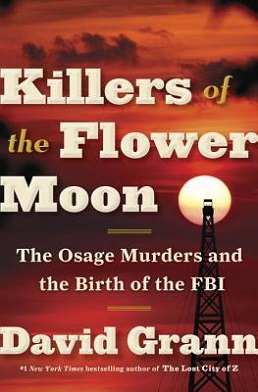
Killers of the Flower Moon: The Osage Murders and the Birth of the FBI is a 2017 nonfiction book by American journalist David Grann about the Osage murders. Time magazine listed Killers of the Flower Moon as one of its top ten nonfiction books of 2017.
Nelagoney is an unincorporated community and census-designated place (CDP) in Osage County, Oklahoma, United States. It was first listed as a CDP prior to the 2020 census.
Whippoorwill is an unincorporated community and census-designated place (CDP) in Osage County, Oklahoma, United States. It was first listed as a CDP prior to the 2020 census.
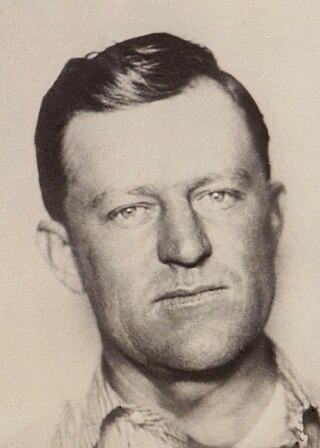
Ernest Burkhart was an American murderer who participated in the Osage Indian murders as a hitman for his uncle William King Hale's crime ring. He was convicted for the killing of William E. Smith in 1926, and sentenced to life imprisonment. Burkhart was paroled in 1937, but was sent back to prison for burglarizing his former sister-in-law's house in 1940. After being paroled for the final time in 1959, Burkhart was pardoned by Oklahoma governor Henry Bellmon in 1965 or 1966 for his role in the Osage murders.
Woodland Public Schools, also known as Woodland School District, is a school district headquartered in Fairfax, Oklahoma. It has an elementary school, a middle school, and a high school.














